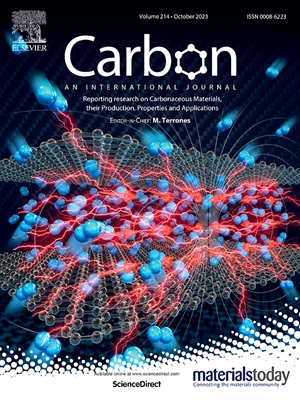双原位合成高强度高导电性石墨烯/铜复合材料的新策略
IF 11.6
2区 材料科学
Q1 CHEMISTRY, PHYSICAL
引用次数: 0
摘要
石墨烯增强铜基复合材料在制备过程中仍然面临石墨烯结构损伤和石墨烯与铜之间界面结合不良的挑战。本研究介绍了一种创新的双原位合成策略,采用四水合乙酸钇(YACT)作为多功能前驱体。原位热分析表明,YACT分解过程中产生的有机气体(C2H2)是石墨烯形成的主要碳源,而释放的还原性气体(H2)作为还原剂,避免了额外的还原步骤。值得注意的是,YACT分解产生的残余Y2O3纳米颗粒通过石墨烯和铜基体之间的双相干桥接建立了强大的界面耦合。这种独特的结构将界面负载传递效率提高了231%,从而充分利用了石墨烯的理论优势。优化后的复合材料表现出优异的机电协同作用:453 MPa的极限拉伸强度(纯铜的256%),25.1%的延展性和99.2%的IACS导电性。这些发现表明,优先分析固体碳源的热分解产物可以优化铜-石墨烯复合材料的设计。此外,消除外部还原过程并将前驱体分解与界面工程协同集成,可以大规模生产高性能铜-石墨烯复合材料。本文章由计算机程序翻译,如有差异,请以英文原文为准。

A novel strategy of dual in-situ synthesis for graphene/Cu composites with high strength and high electrical conductivity
Graphene-reinforced copper matrix composites still face challenges in graphene structural damage during fabrication and poor interfacial bonding between graphene and copper. This study introduces an innovative dual in-situ synthesis strategy employing yttrium acetate tetrahydrate (YACT) as a multifunctional precursor. In-situ thermal analysis reveals that organic gases (C2H2) generated during YACT decomposition serves as the primary carbon source for graphene formation, while the released reductive gases (H2) acting as reducing agents, avoiding extra reduction steps. Notably, the residual Y2O3 nanoparticles derived from YACT decomposition established robust interfacial coupling through dual coherent bridging between graphene and copper matrix. This unique architecture enhanced interfacial load transfer efficiency by 231 %, enabling full exploitation of graphene's theoretical strength. The optimized composites exhibited exceptional mechanical-electrical synergy: 453 MPa ultimate tensile strength (256 % of pure copper), 25.1 % ductility, and 99.2 % IACS electrical conductivity. These findings suggest that prioritizing analysis of thermal decomposition products from solid carbon sources optimizes copper-graphene composite design. Moreover, eliminating external reduction processes and synergistically integrating precursor decomposition with interfacial engineering enable scalable production of high-performance copper-graphene composites.
求助全文
通过发布文献求助,成功后即可免费获取论文全文。
去求助
来源期刊

Carbon
工程技术-材料科学:综合
CiteScore
20.80
自引率
7.30%
发文量
0
审稿时长
23 days
期刊介绍:
The journal Carbon is an international multidisciplinary forum for communicating scientific advances in the field of carbon materials. It reports new findings related to the formation, structure, properties, behaviors, and technological applications of carbons. Carbons are a broad class of ordered or disordered solid phases composed primarily of elemental carbon, including but not limited to carbon black, carbon fibers and filaments, carbon nanotubes, diamond and diamond-like carbon, fullerenes, glassy carbon, graphite, graphene, graphene-oxide, porous carbons, pyrolytic carbon, and other sp2 and non-sp2 hybridized carbon systems. Carbon is the companion title to the open access journal Carbon Trends. Relevant application areas for carbon materials include biology and medicine, catalysis, electronic, optoelectronic, spintronic, high-frequency, and photonic devices, energy storage and conversion systems, environmental applications and water treatment, smart materials and systems, and structural and thermal applications.
 求助内容:
求助内容: 应助结果提醒方式:
应助结果提醒方式:


